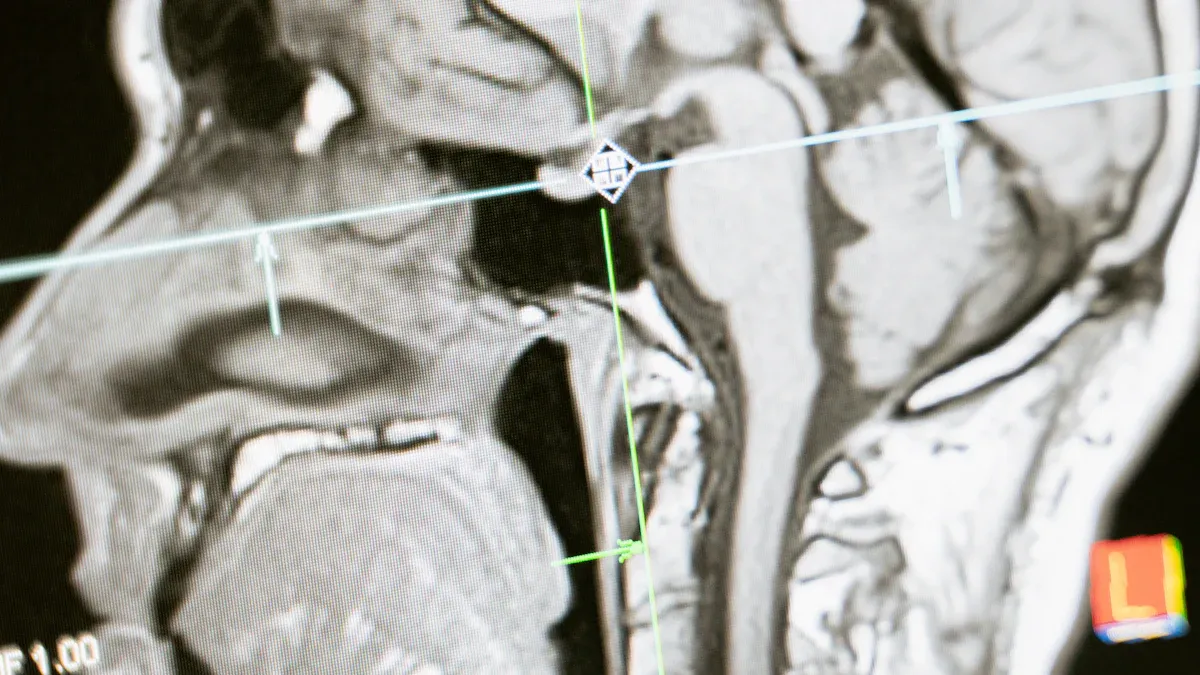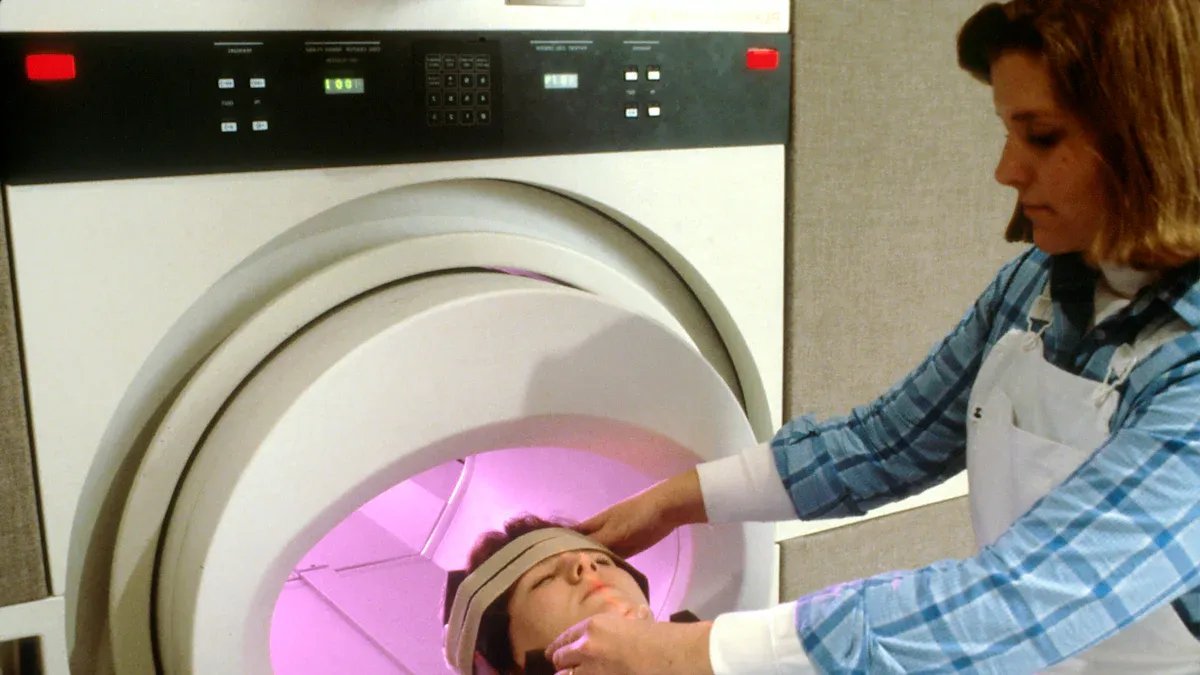Pineocytoma Explained: Key Facts You Should Know

Pineocytoma is a rare, benign tumor that develops in the pineal gland, a small structure in your brain responsible for regulating sleep-wake cycles. This gland produces melatonin, a hormone essential for maintaining these cycles. Tumors in this area can disrupt melatonin production, leading to sleep disturbances and other health issues. Pineocytomas are classified as grade I tumors by the World Health Organization, meaning they grow slowly and have a favorable prognosis. Despite their rarity—accounting for less than 1% of all primary central nervous system tumors—they can cause symptoms due to their location near critical brain structures.
Key Takeaways
Pineocytoma is a rare, non-cancerous tumor in the pineal gland. It can affect sleep patterns and cause different health problems.
Common signs include headaches, trouble walking, memory issues, and blurry vision. See a doctor if symptoms last long or get worse.
Surgery is the best way to treat it. The survival rate after five years is 86% to 91%. Radiation may be used if surgery isn’t an option.
Regular check-ups with MRI scans are important. These help track the tumor and catch any changes early.
Knowing risks like age or past radiation exposure can help you stay aware and take care of your health.
What Is a Pineocytoma?

Definition and Overview
A pineocytoma is a rare tumor that develops in the pineal gland, a small structure located deep in your brain. This gland plays a critical role in regulating your sleep-wake cycle by producing melatonin. Pineocytomas are classified as grade I tumors by the World Health Organization (WHO), meaning they grow slowly and are typically benign. These tumors most commonly occur in adults between the ages of 20 and 60. While they are not aggressive, their location near vital brain structures can lead to symptoms that require medical attention.
Key Characteristics
Pineocytomas have distinct features that set them apart from other brain tumors. They consist of well-differentiated cells that closely resemble normal pineal gland tissue. Under a microscope, these tumors often display unique formations called pseudorosettes, which are not found in healthy tissue. The cells are small and uniform, with round nuclei and delicate cytoplasmic processes. Pineocytomas rarely show signs of rapid cell division, making them less likely to spread or become malignant.
Some additional characteristics include:
Dense sheets of mature cells resembling normal pineal parenchyma.
A low-grade appearance with minimal cellular activity.
A favorable prognosis, with five-year survival rates ranging from 86% to 100%.
Differences Between Pineocytoma and Other Pineal Gland Tumors
Pineocytomas differ from other pineal gland tumors in several ways. Unlike more aggressive tumors, such as pineoblastomas, pineocytomas are slow-growing and less likely to invade surrounding tissues. They are also histologically distinct, featuring rosettes and pseudorosettes that are absent in other types of tumors.
Other differences include:
Pineocytomas are benign, while pineoblastomas are malignant.
Pineocytomas have small, uniform cells, whereas other tumors may show irregular or atypical cell structures.
Pineocytomas respond well to surgical removal, while other tumors may require more aggressive treatments like chemotherapy or radiation.
If you suspect symptoms related to a pineal gland tumor, consulting a healthcare professional can help you determine the cause and explore treatment options.
Symptoms of Pineocytoma
Common Symptoms
Pineocytoma can cause a variety of symptoms, many of which result from its location in the brain. You may experience these symptoms due to the tumor pressing on nearby structures or disrupting normal brain function. Some of the most frequently reported symptoms include:
Headache: A very common symptom that often worsens over time.
Difficulty Walking: This symptom is always present and may affect your balance and coordination.
Cognitive Impairment: You might notice issues with memory, concentration, or problem-solving.
Altitudinal Visual Field Defect: This refers to partial loss of vision, which occurs very frequently.
Hydrocephalus: An accumulation of cerebrospinal fluid in the brain, leading to increased pressure.
Increased Intracranial Pressure: This can cause severe headaches, nausea, and other complications.
While these symptoms are common, their severity can vary depending on the size and location of the tumor.
Severe or Rare Symptoms
In some cases, pineocytoma may lead to rare but severe symptoms. These symptoms often arise from complications caused by the tumor's growth or its impact on surrounding brain structures. Below is a table summarizing some of these symptoms:
Symptom | Synonyms |
|---|---|
Abnormal Eyelid Morphology | Abnormality of The Eyelid, Abnormality of The Eyelids |
Cognitive Impairment | Abnormality of Cognition, Cognitive Abnormality, Cognitive Deficits |
Difficulty Walking | Difficulty in Walking, Walking Disability |
Episodic Ataxia | Intermittent Cerebellar Ataxia, Paroxysmal Ataxia |
Hydrocephalus | Hydrocephaly, Too Much Cerebrospinal Fluid in The Brain |
Increased Intracranial Pressure | Intracranial Hypertension, Rise in Pressure inside Skull |
Nausea and Vomiting | Nausea and Vomiting |
These symptoms may indicate a more advanced stage of the tumor or complications that require immediate medical attention.
When to Seek Medical Attention
You should consult a healthcare professional if you notice persistent symptoms like headaches, difficulty walking, or vision problems. Early diagnosis can help prevent complications and improve your overall prognosis. If you experience severe symptoms such as sudden cognitive decline, uncontrollable vomiting, or worsening balance issues, seek medical care immediately. These could signal increased intracranial pressure or hydrocephalus, which require urgent treatment.
Causes and Risk Factors
Potential Causes
The exact cause of pineocytoma remains unclear. Researchers believe it may develop due to abnormal growth of cells in the pineal gland. These cells, which normally regulate melatonin production, can sometimes grow uncontrollably, forming a tumor. Unlike some cancers, pineocytomas do not spread to other parts of the body. However, their location in the brain can lead to significant symptoms.
Some experts suggest that disruptions in cellular repair mechanisms might play a role. When cells fail to repair DNA damage, they may begin to grow abnormally. While this theory is still under investigation, it highlights the complexity of understanding brain tumors like pineocytoma.
Risk Factors
Certain factors may increase your likelihood of developing a pineocytoma. Although this tumor is rare, understanding these risks can help you stay informed:
Age: Pineocytomas are most common in adults aged 20 to 60.
Gender: Some studies suggest a slightly higher occurrence in males, though the difference is minimal.
Previous Radiation Exposure: Exposure to radiation, especially during childhood, may increase your risk.
It’s important to note that having one or more of these factors does not guarantee you will develop a pineocytoma. Many people with these risks never experience this condition.
Tip: If you have concerns about your risk factors, consider discussing them with a healthcare provider. Early awareness can lead to better outcomes.
Role of Genetics and Environment
Genetics and environmental factors may also contribute to the development of pineocytoma. While no specific gene mutations have been directly linked to this tumor, researchers continue to explore the role of inherited traits. If you have a family history of brain tumors, your risk might be slightly higher.
Environmental influences, such as prolonged exposure to toxins or chemicals, could also play a role. However, evidence in this area remains limited. Scientists believe that a combination of genetic predisposition and environmental triggers may lead to the formation of pineocytomas in some individuals.
Understanding these factors can help you make informed decisions about your health. While you cannot control your genetics, adopting a healthy lifestyle and avoiding harmful exposures may reduce your overall risk.
Diagnosis of Pineocytoma
Imaging Techniques
Diagnosing pineocytoma often begins with advanced imaging techniques. Magnetic Resonance Imaging (MRI) is the most effective tool for identifying this tumor. It provides detailed images of the pineal gland and surrounding structures, helping doctors pinpoint the tumor's size and location. MRI scans can also distinguish pineocytomas from other types of brain tumors based on their unique characteristics.
In some cases, additional procedures may be necessary to confirm the diagnosis. Stereotactic biopsies, which involve using a needle guided by imaging, have a high success rate of 93.7%. Endoscopic procedures, which use a small camera to access the tumor, are another option, though their success rate is slightly lower at 81.8%. These techniques allow doctors to collect tissue samples for further analysis.
Biopsy and Histological Analysis
A biopsy is a critical step in confirming a pineocytoma diagnosis. During this procedure, a small sample of the tumor is removed and examined under a microscope. Pathologists look for specific features, such as the presence of pseudorosettes, which are characteristic of pineocytomas. This analysis helps differentiate pineocytomas from more aggressive tumors like pineoblastomas.
Histological analysis also provides valuable information about the tumor's grade and growth pattern. This data helps your doctor determine the best treatment plan. While biopsies are invasive, they are essential for ensuring an accurate diagnosis.
Challenges in Diagnosis
Diagnosing pineocytoma can be challenging due to its deep location in the brain and the need for specialized procedures. Accessing the pineal gland requires advanced imaging and surgical techniques, which may not be available in all medical facilities. Additionally, the symptoms of pineocytoma often overlap with those of other brain conditions, making it harder to identify without detailed testing.
A multidisciplinary approach is crucial for overcoming these challenges. Neurologists, radiologists, and neurosurgeons often work together to ensure an accurate diagnosis. Advanced imaging techniques, such as MRI, play a key role in addressing these difficulties by providing clear and detailed views of the tumor.
Note: If you experience persistent symptoms like headaches or vision problems, consult a healthcare provider. Early diagnosis can improve your treatment outcomes.
Treatment Options for Pineocytoma

Surgical Removal
Surgical removal is the most common treatment for pineocytoma. Doctors often recommend this option because it offers the best chance of eliminating the tumor. The success of surgery depends on several factors, including the extent of resection, the tumor's characteristics, and your overall health. Complete removal of the tumor typically leads to excellent outcomes.
The five-year survival rate for patients undergoing surgery ranges from 86% to 91%.
A skilled surgical team can minimize risks and improve recovery.
Surgery may involve challenges due to the pineal gland's deep location in the brain. However, advancements in neurosurgical techniques have made this procedure safer and more effective. If your doctor suggests surgery, they will discuss the potential benefits and risks with you in detail.
Radiation Therapy
Radiation therapy is another option for treating pineocytoma, especially when surgery is not feasible or if some tumor remains after surgery. This treatment uses high-energy rays to target and destroy tumor cells. While effective, it can cause side effects that you should be aware of:
Common side effects: Fatigue, headaches, and temporary hair loss.
Serious side effects: Memory changes, cognitive issues, and growth problems in children.
Doctors carefully plan radiation therapy to minimize these risks. They also monitor you closely during treatment to address any side effects. Supportive care, such as medications for headaches or strategies to manage fatigue, can help you feel more comfortable throughout the process.
Observation and Monitoring
In some cases, your doctor may recommend observation and monitoring instead of immediate treatment. This approach is suitable for small, asymptomatic tumors that do not interfere with your daily life. Regular imaging tests, such as MRIs, help track the tumor's growth over time.
Observation allows you to avoid unnecessary treatments and their associated risks. However, you must attend all follow-up appointments to ensure the tumor remains stable. If symptoms develop or the tumor grows, your doctor may suggest surgery or radiation therapy.
Tip: Always communicate any new symptoms to your healthcare provider during the monitoring period. Early intervention can prevent complications.
Managing Side Effects
Managing side effects is an essential part of your recovery from pineocytoma treatment. Whether you undergo surgery, radiation therapy, or observation, understanding how to handle these effects can improve your quality of life.
Common Side Effects and How to Address Them
Fatigue:
Feeling tired is a frequent side effect, especially after radiation therapy. To combat this, prioritize rest and maintain a balanced diet. Light physical activities, like walking, can also help boost your energy levels over time.Headaches:
Headaches may occur after surgery or due to increased intracranial pressure. Over-the-counter pain relievers can provide relief, but always consult your doctor before taking any medication. Staying hydrated and practicing relaxation techniques, such as deep breathing, may also help.Cognitive Changes:
You might notice memory lapses or difficulty concentrating. Brain exercises, like puzzles or reading, can help sharpen your cognitive skills. If these issues persist, consider working with a neuropsychologist for tailored strategies.Nausea and Vomiting:
These symptoms often follow radiation therapy. Eating smaller, more frequent meals and avoiding greasy foods can reduce discomfort. Your doctor may also prescribe anti-nausea medications if needed.
Tips for Managing Emotional Well-Being
Tip: Emotional health is just as important as physical recovery.
You may feel anxious or overwhelmed during treatment. Talking to a counselor or joining a support group can provide comfort. Sharing your experiences with others who understand your journey can make a big difference.
When to Contact Your Doctor
Always inform your healthcare provider if side effects worsen or new symptoms appear. Early intervention can prevent complications and ensure your recovery stays on track.
By staying proactive and following your care team’s advice, you can manage side effects effectively and focus on your healing journey.
Prognosis and Long-Term Outlook
Survival Rates
The prognosis for pineocytoma is generally favorable compared to other pineal gland tumors. Survival rates highlight this distinction. For example, the five-year survival rate for pineocytomas ranges from 86% to 91%, significantly higher than the rates for more aggressive tumors like pineoblastomas. Below is a comparison of survival rates for various pineal region tumors:
Tumor Type | Five-Year Survival Rate |
|---|---|
Pineocytomas | 86-91% |
Pineoblastomas | 10-81% |
PPTID | 84% |
Papillary Tumor | 73% |
These numbers emphasize the importance of early diagnosis and appropriate treatment in achieving positive outcomes.
Factors Influencing Prognosis
Several factors can influence your prognosis if you have a pineocytoma. Age plays a significant role. Patients older than three years tend to have better outcomes, with event-free survival (EFS) and overall survival (OS) rates of 59.9% and 65.2%, respectively. Younger patients, particularly those under three years, face more challenges, with EFS and OS rates dropping to 10%. Treatment choices also impact outcomes. For instance, radiotherapy improves survival rates, while combined craniospinal irradiation (CSI) and focal irradiation yield even better results. Below is a summary of key factors:
Factor | Outcome (EFS) | Outcome (OS) | P-value |
|---|---|---|---|
Age < 3 years | 10% | 10% | 0.001 |
Age > 3 years | 59.9% | 65.2% | 0.002 |
Adjuvant chemotherapy | 49% | 51.5% | < 0.001 |
Radiotherapy | 50.7% | 53.3% | < 0.001 |
CSI vs Focal irradiation | 59.9% vs 16.7% | 65.2% vs 16.7% | 0.02 / 0.04 |
Understanding these factors can help you and your healthcare team make informed decisions about your treatment plan.
Importance of Follow-Up Care
Follow-up care plays a vital role in managing pineocytoma. Regular monitoring ensures that any changes in the tumor or your condition are detected early. Follow-up appointments typically include MRI scans every 6 to 12 months to track tumor growth or treatment response. During these visits, your doctor will also assess any new symptoms or changes in your health.
Key aspects of follow-up care include:
Routine MRI scans to monitor the tumor.
Evaluations of new symptoms or complications.
Timely interventions if changes are detected.
By staying consistent with follow-up care, you can maintain your quality of life and improve long-term outcomes. Early detection of changes allows for prompt treatment, which is crucial for managing this condition effectively.
Pineocytoma is a rare, benign tumor of the pineal gland that can cause symptoms like headaches, vision problems, and difficulty walking. Treatment options include surgery, radiation therapy, and monitoring, depending on the tumor's size and symptoms. Early diagnosis and treatment significantly improve outcomes by preventing misdiagnosis and enabling timely interventions. Regular follow-ups with MRI scans help detect recurrences early, ensuring effective management.
If you experience persistent symptoms, consult a healthcare professional promptly. Early action can make a difference in your prognosis and quality of life.
FAQ
What is the difference between a benign and malignant tumor?
A benign tumor, like pineocytoma, grows slowly and does not spread to other parts of your body. Malignant tumors grow quickly and invade nearby tissues or organs. Benign tumors usually have a better prognosis.
Can pineocytoma turn into a malignant tumor?
Pineocytomas rarely become malignant. They are classified as grade I tumors, meaning they grow slowly and remain localized. Regular monitoring ensures any changes are detected early.
How long does recovery take after pineocytoma surgery?
Recovery time varies. Most people return to normal activities within a few weeks. Your doctor will provide specific guidelines based on your surgery and overall health.
Is pineocytoma hereditary?
No direct evidence links pineocytoma to inherited genetic mutations. However, researchers continue to study the role of genetics in brain tumors. If you have a family history of brain tumors, discuss it with your doctor.
Can lifestyle changes reduce the risk of pineocytoma?
There is no proven way to prevent pineocytoma. However, maintaining a healthy lifestyle, avoiding harmful toxins, and attending regular check-ups may help you manage overall brain health.
See Also
Key Characteristics of Glioblastoma You Need To Know
Essential Information About Carcinoid Tumors You Should Understand
Important Facts About Ganglioneuromas Everyone Should Learn
